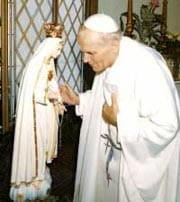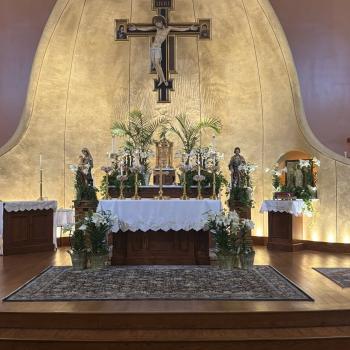 A curious and dramatic artifact from the pontificate of Blessed John Paul II is found in Fátima, Portugal, where a would-be assassin's bullet poignantly sits under the peak of Our Lady of Fátima's bejeweled crown. The bullet was found in the pope's jeep after the 1981 attack on Pope John Paul II's life. Some time later, a grateful pope presented the bullet to the Bishop of Leira-Fátima. The bishop promptly enshrined it in the crown, transforming a lethal image into a beautiful sign of faithful maternal protection and a son's humble gratitude.
A curious and dramatic artifact from the pontificate of Blessed John Paul II is found in Fátima, Portugal, where a would-be assassin's bullet poignantly sits under the peak of Our Lady of Fátima's bejeweled crown. The bullet was found in the pope's jeep after the 1981 attack on Pope John Paul II's life. Some time later, a grateful pope presented the bullet to the Bishop of Leira-Fátima. The bishop promptly enshrined it in the crown, transforming a lethal image into a beautiful sign of faithful maternal protection and a son's humble gratitude.
John Paul II attributed his survival of the shooting to the direct intervention of the Blessed Mother, to whom he had an ardent and lifelong devotion. He was known to suggest total consecration to Jesus through Mary, as recommend by St. Louis de Montfort, as a way for Christians to live out their baptismal promises more readily. He often preached and wrote about inviting Mary's intercession and intervention into one's life.
Some people see it as no small convergence that the failed 1981 assassination attempt targeting a Marian-devoted pope occurred on May 13-- the Feast of Our Lady of Fátima—or that he miraculously survived several gunshots at close range. In his convalescence following surgery, John Paul II requested the Fátima archives to be brought for his review.
Between May 13 and October 13 of 1917, Mary appeared (as "the Lady of the Rosary") to three young shepherd children of Fátima, and she called for true and permanent conversion. Through these young visionaries, the message of prayer (specifically, the Rosary), penance, and reparation for what offends the heart of Jesus, was given to a very troubled world. The apparitions' authenticity was verified by the now-famous miracle of the sun—said to be witnessed by 70,000 people—and the Catholic Church's thorough investigation of the phenomena, the visionaries, and the conversions wrought in the ensuing years.
 The message, also known as "the Secret of Fátima" came in three parts. The first two parts called for specific devotional pieties, and a consecration to Mary's Immaculate Heart. Yet the third part of the message was not revealed for several decades, leading many to wonder and worry about some apocalyptic warning that the Church was not sharing openly.
The message, also known as "the Secret of Fátima" came in three parts. The first two parts called for specific devotional pieties, and a consecration to Mary's Immaculate Heart. Yet the third part of the message was not revealed for several decades, leading many to wonder and worry about some apocalyptic warning that the Church was not sharing openly.
Enter John Paul II, who would go on to make three apostolic pilgrimages of his own to Fátima, just a year after the assassination attempt in 1982, and again in 1991, and in the 2000 Jubilee.
During his final trip, he confirmed the many fruits of Fátima by beatifying two of the original child visionaries: Jacinta and Francisco Marto. The young siblings died in childhood, leaving behind the third visionary, Lucia de Santos, who in 2000 was an elderly religious sister. (Sister Lucia died in 2005, and the cause for her beatification is underway.)
John Paul's homily that day—May 13, 2000—summarized the Fátima message:
The message of Fátima is a call to conversion . . .
Man's final goal is heaven, his true home, where the heavenly Father awaits everyone with his merciful love.
God does not want anyone to be lost; that is why 2,000 years ago he sent his Son to earth . . .
In her motherly concern, the Blessed Virgin came here to Fátima to ask men and women "to stop offending God, Our Lord, who is already very offended." It is a mother's sorrow that compels her to speak; the destiny of her children is at stake. For this reason she asks the little shepherds: "Pray, pray much and make sacrifices for sinners; many souls go to hell because they have no one to pray and make sacrifices for them." (John Paul II, Homily, Beatification Mass, May 13, 2000)





